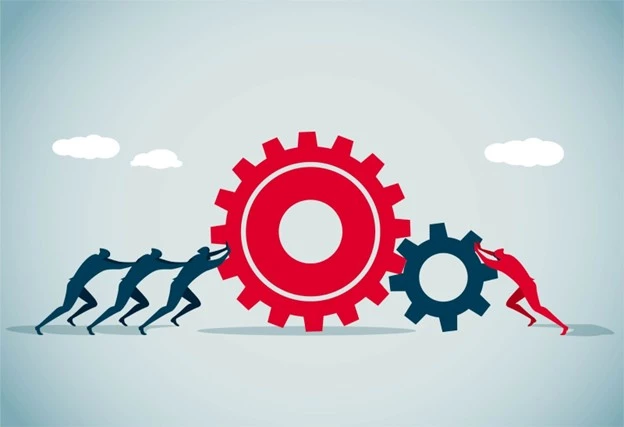“Not finance. Not strategy. Not technology. It is teamwork that remains the ultimate competitive advantage, both because it is so powerful and so rare.”
― Patrick Lencioni, The Five Dysfunctions of a Team: A Leadership Fable
Lencioni’s quote is very relevant to our present-day situation. Adding the word “virtual” to teamwork makes this the most significant statement for 2020. Teams have to work virtually, which heightens the need for trust, productive conflict, true commitment, accountability, and results, The Five Behaviors®!
We are seeing an increased need for “teaming” and collaboration skills with our clients. We are all dealing with a global pandemic, working from home and/or starting to return to work in small numbers and collaborating virtually. While we may have been able to collaborate before – we were in person or working virtually part-time. Now everything depends on our ability to work together virtually and it’s a very different skill. Leaders and teams having to manage themselves in ways they never have had to before and yet even before COVID-19 many teams were struggling to collaborate.
Employees “engaging with their team(s) now accounts for over 60% of employees’ time.”*
“Based on the responses of over 20,0003 employees across a wide array of industries and organizational positions, from individual contributors to C-suite executives, teams suffer from a critical interpersonal skills gap that impedes their potential to achieve.”*
While many of you may be familiar with the model below, we know in working with our clients, just how hard it is to achieve a fully Cohesive Team even in the best of times without building our skills around this and practicing and working on it.
Let’s walk you through the model, and then we can offer some ideas for you and/or your teams.
1: Trust One Another
Members of great teams build trust with each other on a fundamental emotional level and can be vulnerable with each other about their weaknesses, mistakes, fears, and behaviors. They say I am sorry, and I made a mistake, and even I behaved poorly. Their teammates know that they will have their backs, support them when things go poorly, and hold them accountable for their word and commitments. They can be completely open with one another, without filters. This foundational behavior is essential for the team to be able to engage in the other four behaviors. No trust with team members: Nearly four in five people report that their team members are typically not willing to acknowledge their weaknesses to one another, which highlights the pervasive lack of vulnerability-based trust throughout the workplace.
2: Engage in Conflict Around Ideas
Members of teams who trust one another are not afraid to engage in conflict around ideas that are key to the team’s and the organization’s success. They do not hesitate to disagree with, challenge, and question each other, all in the spirit of finding the best answers, discovering the truth, and making great decisions; this is productive conflict. This behavior is essential because by going through the conflict, the team tests ideas and concepts and learns the strengths and weaknesses of all the competing approaches before having to commit to the chosen ones. Without the conflict, the team may not get the best ideas or be able to truly buy-in and commit.
3: Commit to Decisions
Teams that engage in productive conflict around ideas can gain total team buy-in so that members can commit to decisions, even when various members of the team initially disagree. That is because they ensured that all opinions and ideas were put on the table and considered, giving confidence to team members that no stone has been left unturned. Once members buy-in, they can then commit to moving in a direction that will lead them to success. This buy-in and commitment made possible by trust inside the team are crucial to moving the team forward and working towards results and provides a basis for the next behavior, accountability.
4: Hold One Another Accountable
Teams that gain commitment to decisions and standards of performance do not hesitate to hold one another accountable for adhering to those decisions and standards. What’s more, they don’t rely on the team leader as the primary source of accountability; they do not need to, they trust each other to be working toward the good of the team and the organization. Accountability is essential to getting to results and building more trust inside the team. From Wiley’s study, 59% of people say their team members don’t take personal responsibility to improve team performance moving forward.
5: Focus on Achieving Collective Results
Team members who trust one another, engage in conflict around ideas, gain commitment to decisions, and hold one another accountable set aside their individual needs and agendas and focus on achieving collective results. They do not give in to the temptations to place their departments, career aspirations, or ego-driven status ahead of the collective results that define team success.
Virtual Teamwork
As we said earlier, we see many great teams and individuals struggling with moving to “virtual” teamwork; pre-COVID and especially now, away from the office faced with high levels of uncertainty. Business Leaders are highly stressed, trying to keep the business afloat during these times. Teams that are now mostly virtual need to be operating more independently and filling the gaps left where the business leaders are not available. Virtual teams must have vulnerability-based trust with each other, knowing that even though they are not together physically, their fellow team members are working for the team and organization success. They have to find ways to engage in productive conflict to be able to get buy-in and make commitments so that they can hold each other accountable and deliver great collective results.
“If you could get all the people in an organization rowing in the same direction, you could dominate any industry, in any market, against any competition, at any time.”
― Patrick Lencioni, The Five Dysfunctions of a Team: A Leadership Fable
What do you do if you want to build teaming skills but are not part of an intact team, but rather part of multiple teams? Or do not have time for your team to form to the point where the Five Dysfunctions of a Team™ or the Five Behaviors of a Cohesive Team™ assessments are valid?
We have a solution: Five Behaviors Personal Development™ 90-minute training session, and a webinar session with Patrick Lencioni in August when you buy one Personal Development Assessment. If you are interested in learning more about this offering, please email us.
“Teamwork is the key to success in business. Virtual teamwork is a necessity of our times and the future.“ – Lori Heffelfinger
Lead on!
Lori & James
Lori Heffelfinger, MSOD, PCC & James Jackman, MSOD
310-543-7632 office
www.heffelfingerco.com
Resources:
* State of Teams whitepaper by The Five Behaviors® (email us if you would like this whitepaper)
Video: Are you an ideal team player? | Patrick Lencioni | TEDxUniversityofNevada
Video (2:10): Five Dysfunctions of a Team







